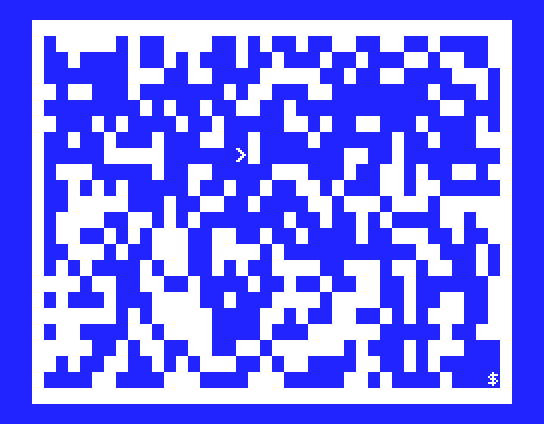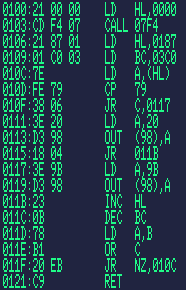 Labirint
Labirint
I considered some kind of labyrinth a must for this series. The problem was not
to
implement game rules or even to generate a random maze, but to do it reasonably
fast so player won't fall asleep while program draws maze.
I decided that regualr spatial maze should be combined with a time measurement,
since just passing through maze where all passes can be clearly seen seems
trivial. As a consequence, program was supposed to be restarted many times, so
it was very important to fill the screen quickly.
Rules

Run from upper left corner to bottom right as fast as you can.
Labyrinth will be the same every time, so you have chance to try different
ways.
Code and comments

Download the original LABIRINT.NSG code
or version for international character set.
 Major trick here is to use machine code subroutine to fill screen with random
noise. Subroutine is placed in string variable T$ and DEFUSR
statement initialises user function to whatever this variable's descriptor
points to. Subroutine is written in a way that would allow it to execute at any
address (the picture on the right shows it placed at address 0x100).
Major trick here is to use machine code subroutine to fill screen with random
noise. Subroutine is placed in string variable T$ and DEFUSR
statement initialises user function to whatever this variable's descriptor
points to. Subroutine is written in a way that would allow it to execute at any
address (the picture on the right shows it placed at address 0x100).
It scans ROM starting at predefined (0x187) address and prints a code for
filled block (0x9b for MSX in question, should be 0xDB for "international"
codepage), for every byte that is less than threshold (0x79) or space
otherwise. I had to play with starting address and threshold to find decent
looking screen. It can be different for different MSX, but I guess, BIOS area
is always the same.
I cannot quite remember what BIOS call to 0x7F4 does. Probably it is “set
start VRAM addres for writing” or something like that.
Other minor tricks include
- USR() function returns its argument (unless it uses some special
BIOS calls to modify it, which this specific function does not). This is used
to call screen filling routine and provide initial value for border drawing
part.
- Memory cell at 0xF3B1 holds screen height for display driver.
- <ESC>L inserts empty line at cursor
- U=SIN(1) acts as a delay for video effect.
[ MSX BASIC
| << Previous
| Next >>
| Feedback
]
 Labirint
Labirint Labirint
Labirint

 Major trick here is to use machine code subroutine to fill screen with random
noise. Subroutine is placed in string variable T$ and DEFUSR
statement initialises user function to whatever this variable's descriptor
points to. Subroutine is written in a way that would allow it to execute at any
address (the picture on the right shows it placed at address 0x100).
Major trick here is to use machine code subroutine to fill screen with random
noise. Subroutine is placed in string variable T$ and DEFUSR
statement initialises user function to whatever this variable's descriptor
points to. Subroutine is written in a way that would allow it to execute at any
address (the picture on the right shows it placed at address 0x100).